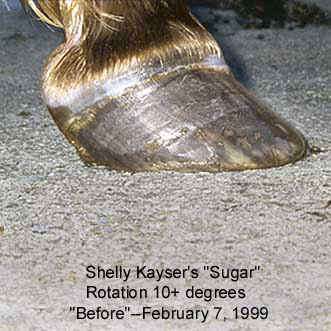
Treating Founder (Chronic Laminitis) without Horseshoes, Section 3
(Version with full-sized photos)
Some of the means for treating founder mechanically, rather than pharmaceutically:
1. Very frequent barefoot trims of a specific wild horse shape to increase circulation in the feet. This is something the horse owner can learn to do at home very inexpensively.
2. Leaner feed and more exercise. More exercise and a freer boarding situation also increase circulation in the feet. However, starvation is not the answer, either--a certain amount of protein is needed to grow new hoof wall! What I hope to warn people about, though, is an overly rich diet, especially in horses not getting any exercise. Straight alfalfa hay free fed and 2 big coffee cans of sweet feed a day can be enough to founder many horses, and I hear from barns that feed this way where many of the horses are "sore."
3. The increased circulation and returning the bottom of the coffin bone to a ground-parallel position stops overloading the laminae in the toe area and enables the laminae to heal and grow a better, stronger connection. Correct trimming that restores full circulation will also grow thicker and stronger soles and hoof walls. This can result in the horse's feet actually getting better than before he foundered.

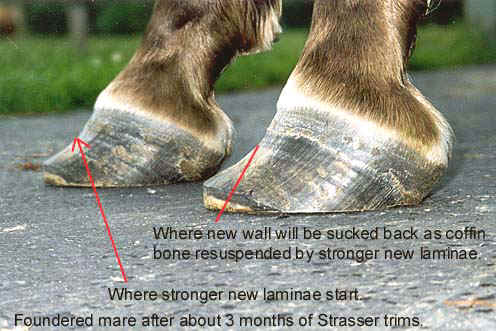
Shelly Kayser's "Sugar"--February 7, 1999 (top) and May 24, 1999 (bottom)
Heels still too high in May photos!
(Photos of Sugar courtesy Shelly Kayser)
In the February photo the toe wall is pulling away from the
coffin bone higher up than it is in the May photo.
Toe backed up to white line 2-3x week--
constantly keeps leverage off during recovery
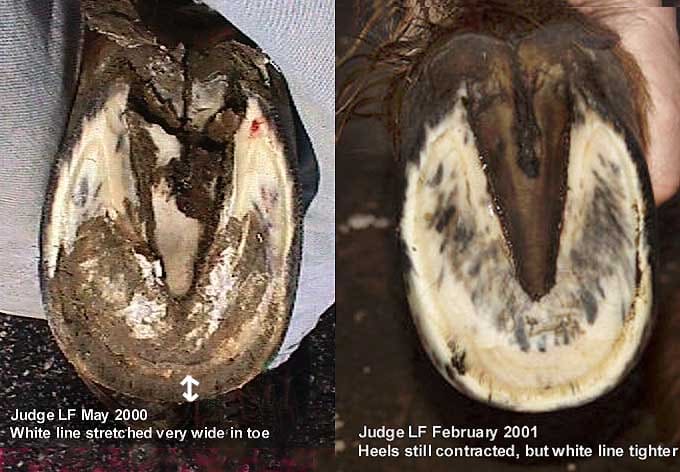
John Rosch's foundered TWH (above) shows a stretched out white line at the toe shrinking back to a much tighter, narrower size, despite less than perfect trimming and not doing it often enough. The heels are still contracted because he was not doing opening cuts, but in general, the horse went from being barely ambulatory to being rideable again.
4. Increasing circulation through increased exercise and a constantly maintained correct hoof shape will make the horse far less likely to founder in the future
Increasing circulation through increased exercise and constantly maintained correct hoof shape is the key to fixing lamintis, because laminitis is caused by deformed hoof shape (high heels) and reduced hoof mechanism (due to shoeing, poor trimming, and lack of movement) that results in impaired circulation.
Hoof mechanism refers to the movement of the hoof when the horse puts weight down on it, and then takes it up again. A horse with proper hoof mechanism will have his heels visibly spread each time he puts weight on a foot. Nailed on metal shoes severely limit this movement, which is so vital to optimum circulation:
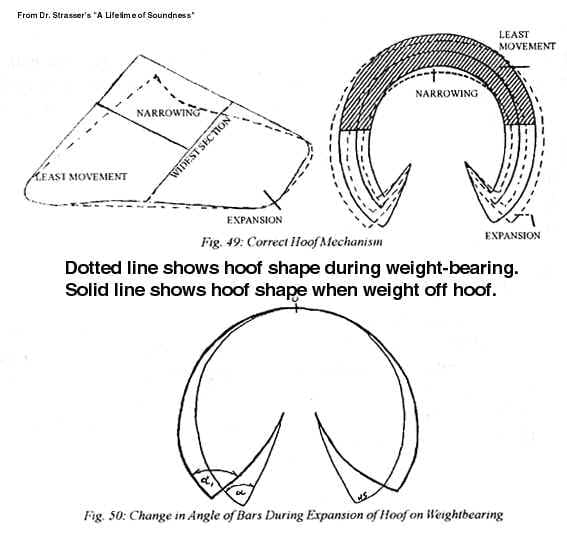
(From Dr. Hiltrud Strasser's "A Lifetime of Soundness")
The above illustration animated:
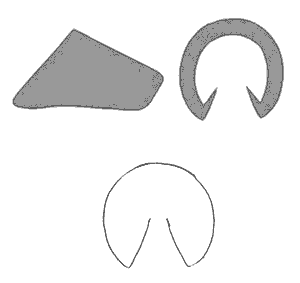
Hoof mechanism in action
How can you possibly get this sort of movement
when the hoof is fixated with a nailed-on shoe?
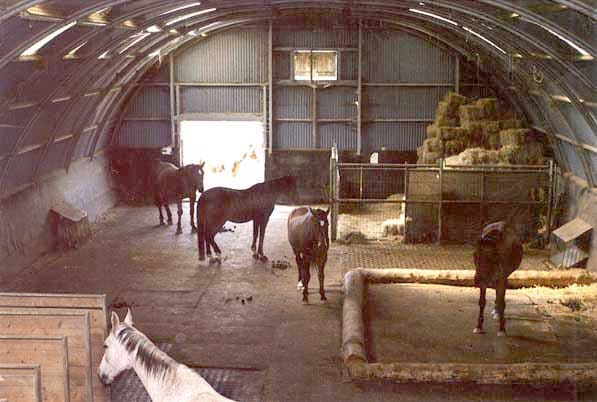
Dr. Strasser's Hufklinik
(Photo courtesy of Nancy Filbert)
Dr. Strasser's Hufklinik, pictured above, is a radical departure from most lameness clinics. In most veterinary hospitals, the horses are separated and confined in stalls; exercise and social life are minimal. In Dr. Strasser's clinic, however, the patients are free to come and go between the barn and the field, and have constant freedom and companionship. Certainly this improves their morale. The barn floor is mostly covered with rubber mats, which are firm enough to encourage heel expansion and hoof mechanism, but still smooth and non-concussive to make lameness patients as comfortable as possible. The tie stalls (lower left) are only used to separate them when they are grained. This set-up encourages more movement.
Rather than keeping lame clinic horses booted all the time, there are rubber floors, even on outdoor paths. The rubber flooring is smooth and firm enough to enable hoof mechanism, but also smooth and resilient for comfort. Leaving the hooves exposed to air has many benefits, which are lost when you keep the feet booted or casted to keep it padded and more comfortable. Keeping the hoof in a water-tight boot or cast encourages thrush and keeps the hooves too moist and soft.
The Hufklinik has hay and water in many locations both indoors and outdoors to encourage movement, rather than having all the feeding and watering at just one location. The hay feeders encourage slower eating, and protect hay from being rained on. Note the bottom is sloped so more hay slides down as it is eaten. This homemade feeder would be easy to copy. The hasp enables keeping the lid from being opened.
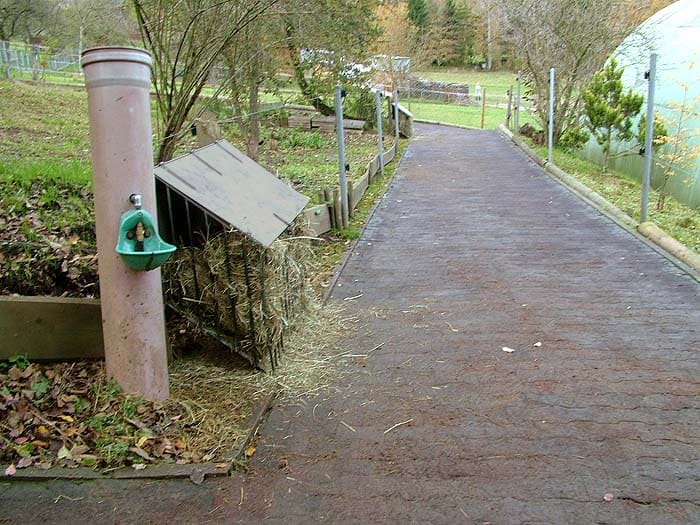
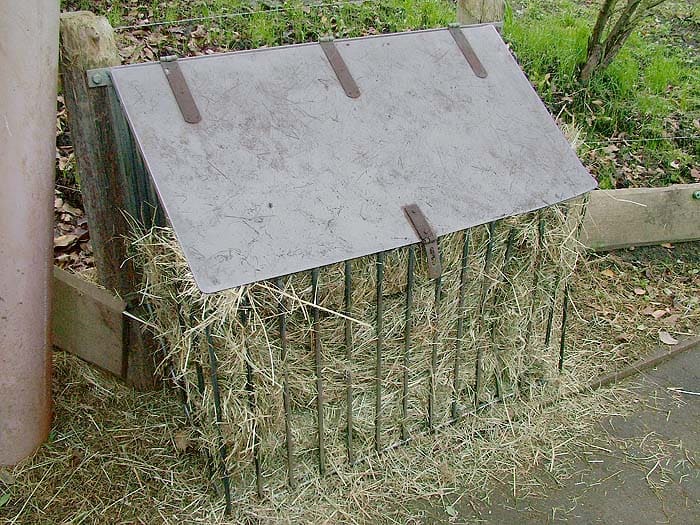
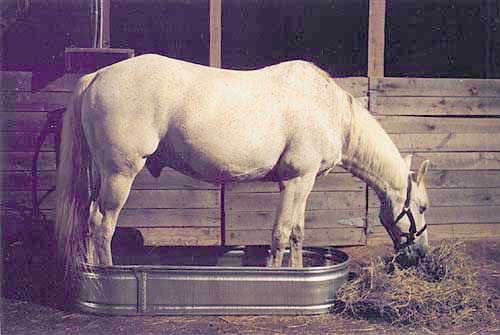
Max soaking his feet
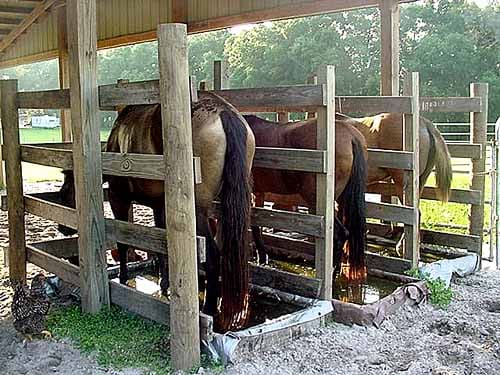
Daily exposure of hooves to water: feeding/soaking stalls.
Photo, Anne Daimler CSHS
Daily exposure of hooves to water (15-20 min.) during dry weather conditions simulates horses getting their feet wet while drinking in ponds and streams, as they would in the wild, and keeps the hooves flexible enough to enable more hoof mechanism and heel expansion. (My horse, Max, munching his hay untied while soaking in a 2' x 6' x 1' galvanized sheep watering tank. The advantage of this tank is that it is easier to change the water than larger soaking pools; changing the water more often discourages mosquito breeding.)
Another benefit of having optimum hoof mechanism is that the hooves become more self-cleaning. Shod horses are more likely to have thick build-ups of mud, or ice in the winter. Many of the people on the naturalhorsetrim list have marveled at how their horses are flipping out patties of ice, rather than having the big "snowballing" problem they had had in the winter when the horses were still shod. People often try spraying the bottoms of their shod horses' hooves with PAM cooking oil spray, or even WD40, but this works a lot better! Here is a mud "hoof patty" that hoof mechanism is enabling my animals to expel naturally and often:
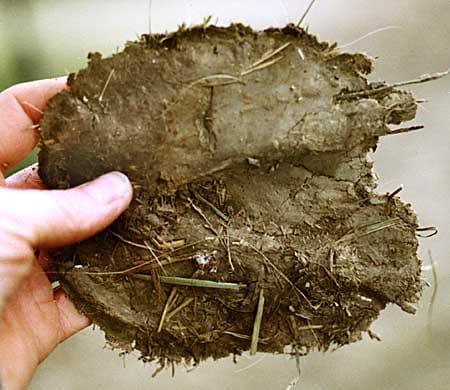
Hoof patty....I find lots of these laying around.
The image below, from Jaime Jackson's book, explains why hoof mechanism is so important to optimum circulation:
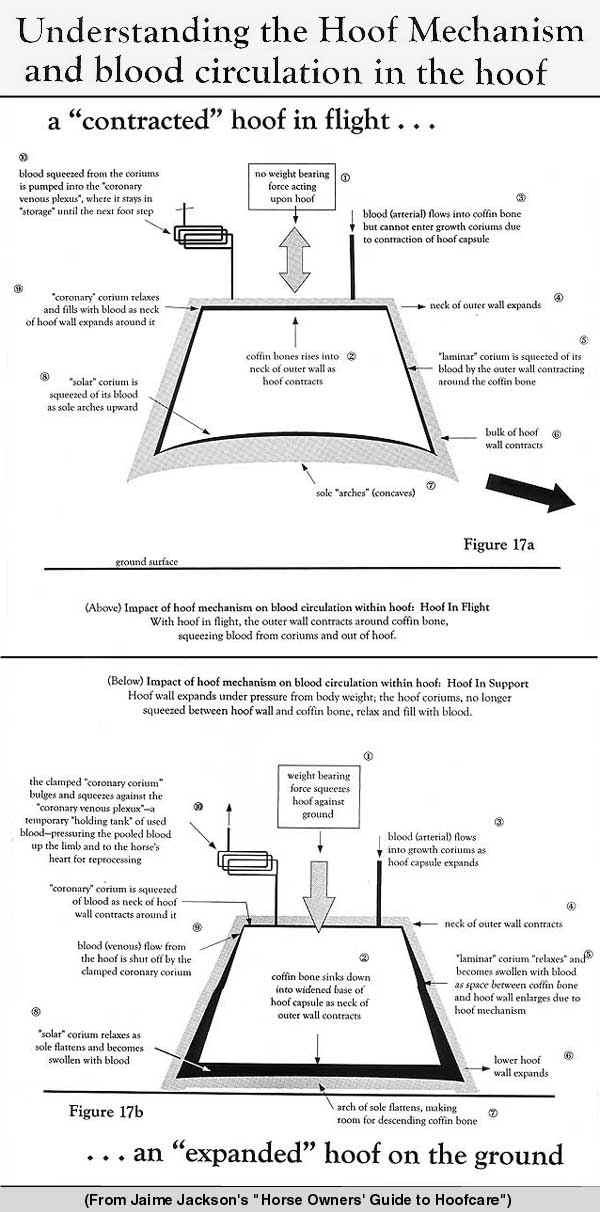
Another popular fix for founder is the heartbar shoe. It supposedly prevents coffin bone rotation by providing frog support under the coffin bone. It cannot be reset often enough to keep the frog support in constant contact, though--rapid heel growth typical of foundered horses will lift the frog up off the frog support long before the next reset. Also, it severely limits hoof mechanism. This results in lessened circulation. Less circulation has a numbing effect; the apparent lessening of pain is due to this numbing effect. Poor circulation also results in weaker laminae growing in. My horse, and the horses of many of my web page readers, did not have any structural improvements with heartbars, although they do have a palliative effect. Max's white line remained stretched out for several years in bar shoes. Here is Max in a heartbar:
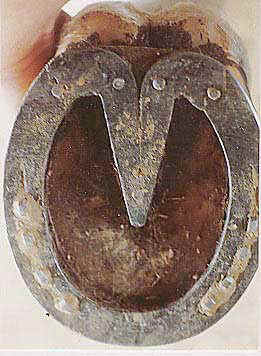
Dr. Strasser explains why heartbars and other frog support shoeing methods do not work in the long run:
| “A rotated coffin bone, which can result from several different causes, is a change in the position of the coffin bone. The sensitive laminae, which normally hold the coffin bone firmly in place, decay, allowing the toe of the coffin bone to drop. This then presses on the sole, which causes inflammation and changes to the laminae and bone of the toe. New horn no longer grows in this region; only a secretion is produced from the affected area. Eventually, as the sole is worn away from below and the horn on the inside of the sole decays, the tip of the coffin bone protrudes through the sole.
“The usual orthopedic treatment to prevent the protrusion of the coffin bone and return it to its physiologic position is to apply artificial pressure from below. This is attempted by, for example, a padded bar across the middle of the shoe. "In contrast to this, healing can occur when the hoof, through correct trimming, is returned to its optimal, natural form, in which the mechanical action of the hoof will resuscitate the laminae." (Published in Jaime Jackson's newsletter; used with permission) |
The trimming method I am advocating will not result in immediate pain reduction. Often, restoring circulation will also restore feeling, including more pain. Much like the pain in your hands when you come in from a cold winter's day, and your hands are half-frozen. As they warm up and circulation returns, there is often pain. Further, much of the body's repair process will involve hoof abscesses, which are very painful. However, if you are in it for the long haul, you can actually get real structural improvement instead of merely temporary pain reduction. The horse being in pain, especially abscessing, can be really hard to take at the time. Still, in the long run, you can get more healing and structural improvements. It pays off eventually!
While I also discuss medication and nutrition, the chemical approach alone will not work. The mechanical approach is by far the more important factor in the equation.>> Denise McLain, the owner of Nova, whose story follows, tells me that the years of being on bute and isoxuprene did not help her horse at all. He continued to get worse until Sabine Kells took over his treatment--just trimming him and keeping him moving, and no drugs.
The pharmaceutical approach is very dangerous! I have been hearing from more and more people whose horses are on 5 or 6 different prescription drugs simultaneously. The bute/banamine combination is quite common, and often results in stomach ulcers. These horses eat and drink less and less, until they dehydrate, and then either suffer colic or kidney failure. They are killing the horses with kindness, and trading foot pain for abdominal pain. The horses Dr. Strasser has had the most trouble turning around are the ones who have been literally poisoned with excessive medication.
Further, suppressing inflammation with medication is actually counter-productive.
| To quote Dr. Strasser (from Jaime Jackson's newsletter):
[conventional] Veterinary treatment, however, focuses mainly on the inflammation, or the already occurred rotation of the coffin bone. However, seen from a pathophysiological point of view, inflammation is a functional measure for repair; through increased blood flow, metabolism (the exchange of waste products for nutrients and oxygen) is intensified. Basically, an inflammation is a natural repair mechanism; it causes pain, but has a function, and suppressing it (as with anti-inflammatories) prevents this natural healing mechanism from working. This suppression of inflammation is usually done through medication and/or wedge pads. Metabolism diminishes, and healing becomes slow if not impossible, since healing requires increased metabolism. |
Another common feature of killing with kindness is feeling too sorry for the horse to insist on him getting up and moving....so the horse can be left lying down for 8 or 10 hours at a time. It may be natural for us to lie down for 8 hours at a time, but it is totally abnormal for a horse to do the same. Horses' feet do not get optimum circulation unless they are walking most of the time. Wild horses living naturally cover a good 15 miles a day, mostly at a walk, and rarely lie down more than an hour at a time. The seemingly cruel action of making a sore horse get up and move will actually help him and reduce inflammation. When my horse was sore and had heat in his feet, walking him for 15-20 minutes has always resulted in less heat and soreness--movement really helps.
One of the least traumatic recoveries from severe (26 degrees) rotation and founder of 6 years' duration I have heard about is a horse whose owners trimmed to get the correct hairline slope, and then turned the horse out on 400 acres of desert with a young, active endurance racing horse to really keep him motivated to keep moving. Here is someone who summoned the courage to go 100% on natural board, frequent barefoot trims and constant movement...and was rewarded with much faster results! Because of all the movement Boogie is getting, his hooves are growing out about twice as fast as they would "normally." Despite the amount of damage he had from 6 years of being foundered, he has had less abscessing than I would normally expect, and his abscesses resolve faster than a less active horse's would.
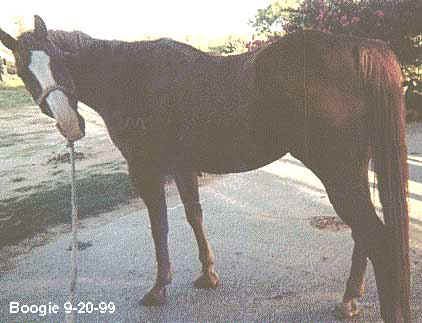
Boogie, September 20, 1999, after heels lowered.
A brief history of Boogie: older QH gelding who foundered after getting a penicillin shot mistakenly in a vein instead of a muscle, and was rather crippled for 5 years. He had been foundered for several years, and was retired. He was shod, but continued to deteriorate. He was quite lame; he had persistent thrush, and high, contracted heels. He sweated quite excessively--I have no information if this was because of being in constant pain, or because of some metabolic disturbance. However, it cleared up after his heels were significantly lowered. At this time, also, his coat began to change from dry, dull and patchy to softer, finer and shinier.
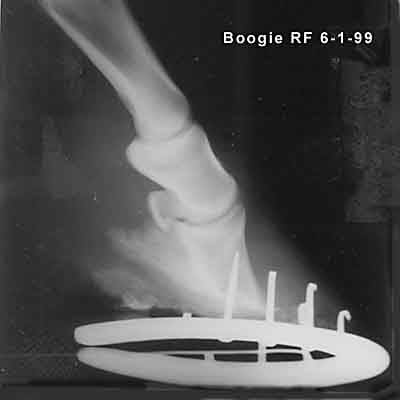
Boogie "Before"--rotation in the mid-20's.
In mid-August, 1999, his shoes were pulled after Rachael read my site. The heels were lowered a little, and they expanded some. The horse was doing slightly better--at least it was a reversal of the direction things had been going in, but only modest improvement. In mid-September, we began corresponding, and I sent her the most recent trimming photos that are now on the site, but weren't back then. Although lowering the heels a lot more on 9-15-99 to get the correct hairline slope seemed really radical, she summoned the courage to go all the way with the Strasser approach--hairline slopes, opening cuts, no drugs--and keeping him moving. She had never had this horse stand square on the RF before. After he was correctly balanced laterally (after studying the lateral balance info I sent), his suddenly standing squarely on his RF was a nice surprise.
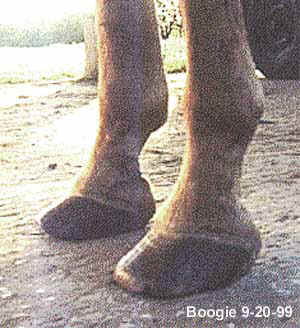
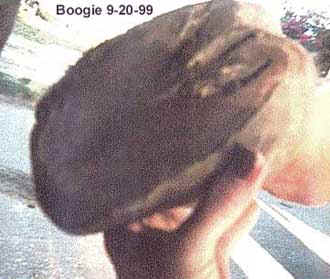
Boogie, September 20, 1999, after trying to get hairline slope.
This trim is still not correct, but better!
Bulge in hairline shows lateral walls still too high.
Bars not right, no opening cuts, etc.
Breakover is still not backed up enough.
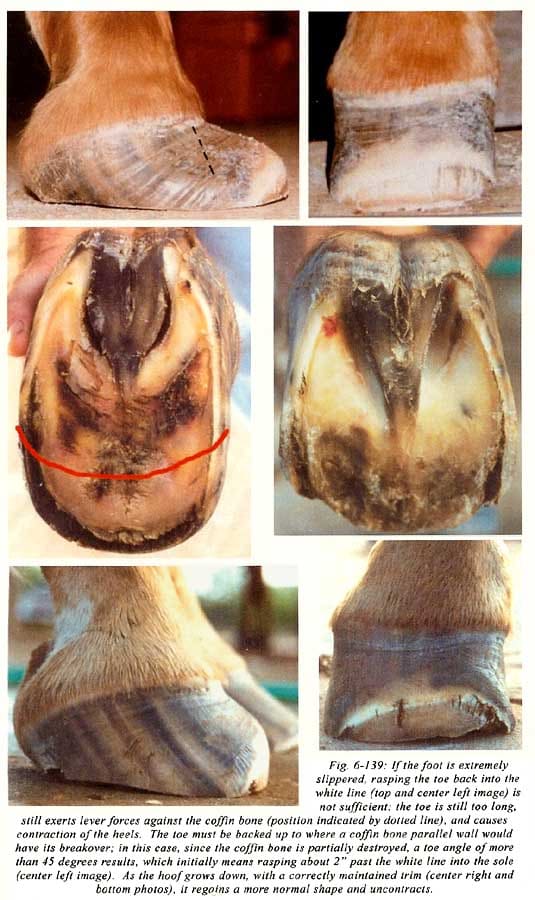
Further discussion of Boogie, from Strasser textbook, figure VI-102.
On 9-17-99 he was very sore! But what turned the tide was that she did not succumb to the temptation to rest him and reach for the bute, etc.--instead she turned him out with the young Arab to keep him moving and let him heal himself. He was roaming constantly on several hundred acres, and spending extra time soaking his feet in the watering holes. (This daily exposure of hooves to water is another point of natural living conditions that Dr. Strasser emphasizes.) On 9-19-99 he was loping! More active and less sore. Just 3 days of Boogie putting on a lot of miles after an improved trim worked wonders. The high miles really got his circulation going in his feet so he could heal himself. Some of his other problems--the excessive sweating, poor coat quality and persistent thrush--cleared up rapidly on this program.
Although taking off enough heel to get the correct hairline slope seemed radical, she did it anyway. She tried to copy the other features of the trim as well. He went from barely walking to cantering in days, completely drug-free. He is getting rowdier every day! The ease of his recovery is remarkable! (I credit his ideal natural boarding situation with this. Just doing the trim well is not enough--getting enough movement is key.)
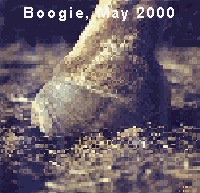
Boogie after the May, 2000 Strasser clinic--
toes backed up quite dramatically.
Despite a recent bout of sole sloughing, he never quit roaming the acreage, or cantering.
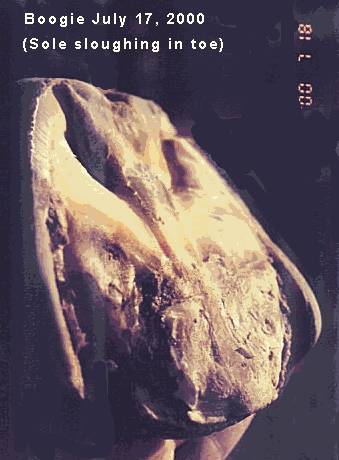
Boogie, July 18, 2000, Sole sloughing
Apparently no one told him sole sloughing was a death sentence, as he was still making himself scare on the acreage during this phase. New sole grew back despite the fact that he was not even bandaged--he just got daily apple cider vinegar and water soaks. (Bandages would not stay on him because he was too active. He also ran through a fence at a gallop to get at his girlfriend in this "hopeless" condition!)
I entirely credit his level of activity and his living out in a herd in a really large area with how well he is taking phases of recovery that would have confined horses in agony. Having a good trim is only half the battle. (He was making no progress in this ideal natural board set-up before he was de-shod and trimmed, however. You need both elements--the trim, and high activity levels in natural herd life24/7.)
I get so many people trying to get reassurance from me that the idea of overnight stalling is OK. If you want optimum results--and FAST results--it isn't! The more freedom and movement once you've done a correct trim and returned the bottoms of the coffin bones to a ground-parallel position, the better.
Further, solitary confinement in a stall is bad enough on a horse's morale when he is well, but when he is in pain, he has nothing to focus on except his pain. Horses are intensely social animals; they are far more needy of companionship than people are. If at least his emotional needs for a herd life and freedom to roam are being met, his morale will improve considerably. That might be just the additional edge between a horse continuing to try, and horse ready to give up. Yet so many horses are treated like cars: bring them in for mechanical repairs (by the vet or farrier), and then park them in the garage (stall). This is ignoring their spirits. They are not just bodies; they have emotional needs as well. They instinctively want the company of others for both companionship, and the mutual protection that a prey animal needs. They also feel safer in spaces large enough that they can run away from potential attackers. A stall with bars on the front and solid walls on the other three sides is remarkably like a human jail cell. Solitary stall confinement denies their needs for movement, freedom, room to roam, and companionship.
Many of the horses being "killed with kindness" end up being euthanised. (over-fed, over-medicated, under-exercised, and confined to a stall)
|
Despite how simple and inexpensive the mechanical approach can be, it can work better than approaches costing thousands of dollars. Boogie is making more progress, at practically no cost at home, than he ever would have made in a hospital setting for $1000-2000 month. I made no progress hauling my horse 2 hours each way to a university vet school and having him maintained in heartbars. One of the reasons for this is that they only reset him every 8 weeks. I made much more progress staying home and doing my own trimming more often.
I am very sorry to have to report that Boogie died in November, 2002. Although full tests were not run, when we submitted his whole story to Dr. Kellon, she thought it sounded like West Nile Virus. He also had some evidence of snake bite.
If you are not prepared to do your own trimming, however, you will end up spending more on farrier services, as the commonly accepted standard of trimming every 6-8 weeks is entirely too infrequent. The more often you trim the faster your progress. I would caution you that there are only a few Strasser-certified hoofcare specialists in the USA yet; do not assume your farrier understands how to do this trim. I have seen some fairly mind-boggling photos of "natural trims" and "wild horse trims" that are not even close.
Back to home page--Table of Contents
Article in sections with "thumbnail" photos for fastest downloads:
1 9 17
2 10 18
3 11 19
4 12 20
5 13 21
6 14 22
7 15 23
8 16 24
NAVICULAR
Article in sections with full-sized photos for print-outs:
1 9 17
2 10 18
3 11 19
4 12 20
5 13 21
6 14 22
7 15 23
8 16 24
NAVICULAR
To Strasser case studies--thumbnail photos for faster downloads
To Strasser case studies--large photos
Please sign my guest book! Photos of my pets My farm
Share Barefoot success stories on this page
Buy or sell used HORSE BOOTS Natural board Barn Listings
Click here to subscribe to naturalhorsetrim
(I moderate this listserv to weed out "fluff.")
Send Email to Gretchen Fathauer, or call (740) 674-4492
Copyright by Gretchen Fathauer, 2015. All rights reserved.